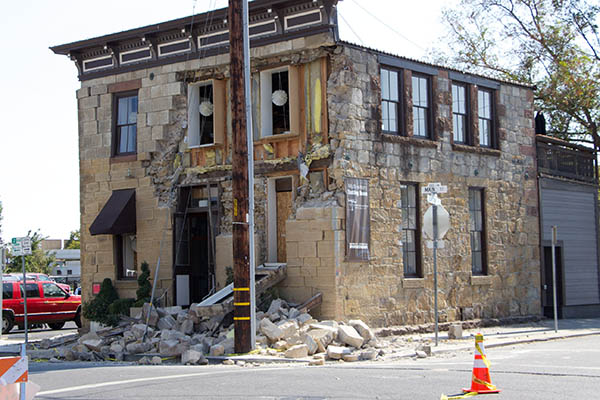
by Harvey Leifert Wednesday, December 17, 2014

A damaged building in Napa, Calif., following the magnitude-6 earthquake on Aug. 24, 2014, which struck south of the city. Credit: ©James Gunn, CC BY 2.0.
San Francisco — The magnitude-6 earthquake that shook buildings and rattled wineries in California’s Napa Valley on Aug. 24, 2014, continues to affect homes in at least one neighborhood in the city of Napa more than three months later. The quake’s epicenter was about 6 kilometers south of the city, but post-quake movement, or afterslip, along the principal fault line to the north of the epicenter is ongoing, according to a fast-track report prepared by the U.S. Geological Survey (USGS) for the Federal Emergency Management Agency. Scientists involved in producing the 51-page report — released to the public on Tuesday — discussed it at a press conference at the annual meeting of the American Geophysical Union in San Francisco.
USGS geophysicist and report lead author Ken Hudnut told reporters that the fault — one of several parallel faults within the West Napa Fault Zone — has continued to move, at a steadily decreasing rate, since the earthquake. Although the afterslip phenomenon is well known from previous quakes, this is the first time that strong afterslip has been observed in a populated residential community. The fault experiencing afterslip, referred to as the “main strand” in the report, runs under Napa’s Browns Valley neighborhood and is deemed a “moderate” hazard going forward, meaning it is expected to slip between 5 and 15 centimeters in the next three years, followed by reduced slip until 2024. It is thought to have slipped about 0.45 meters during the quake. (No faults in the area covered by the report were found to be at greater than “moderate” risk.)
One of the key concerns is whether homes damaged in Browns Valley should be allowed to be repaired and reoccupied, particularly if they are at ongoing risk. Under California’s Alquist-Priolo Act, the California Geological Survey must prepare fault maps and assess the future risk near faults known to be subject to slipping. New construction generally cannot be closer than 15 meters to an active fault.
Although much of the surface rupture during the Aug. 24 quake occurred in sparsely populated agricultural areas, Browns Valley was a notable exception. In fact, the South Napa earthquake is the first to have caused surface rupture in a densely populated area of California since the 1906 San Francisco quake, according to Julien Cohen-Waeber, a graduate student at the University of California at Berkeley who has studied damaged buildings in the Napa vicinity. He told reporters that information gleaned from the recent event would be useful when the next big earthquake hits a populated area.
Roughly 20 homes, with a total value of about $100 million, stand along the main strand fault. An additional 200 homes line other faults that USGS describes as having a “low” risk of afterslip, meaning the faults are likely to experience less than 5 centimeters of movement over the next three years. The USGS report is intended to assist state authorities in determining the fate of those houses.
In Browns Valley, surface rupture from the South Napa earthquake zigzagged across streets in some cases, causing only hairline cracks in one house, for example, while moving a neighboring house 6 centimeters off its foundation and causing severe structural damage. Cohen-Waeber investigated 27 residential houses, all of which had wooden frames and were either one or two stories high. He found that the type of foundation played an important role in the structure’s resistance to damage from shaking. Overall, light, wood-framed structures not directly situated on the ruptured faults performed very well, he said, as did new and retrofitted construction. Where damage did occur, it was often to chimneys, according to the USGS report.
Napa Valley’s economy rests mainly on agriculture, notably its wine industry and the tourism it draws. Hudnut said that some wineries had been damaged in the quake, including damage to stainless steel vats and barrels that were toppled by the shaking. At one vineyard, the surface trace of the fault rupture could be seen as a slight jog in otherwise straight, parallel rows of vines. Although some vintners were concerned that Napa might suffer economically, Hudnut said that the feared drop in tourism following the quake has evidently not occurred.
© 2008-2021. All rights reserved. Any copying, redistribution or retransmission of any of the contents of this service without the expressed written permission of the American Geosciences Institute is expressly prohibited. Click here for all copyright requests.